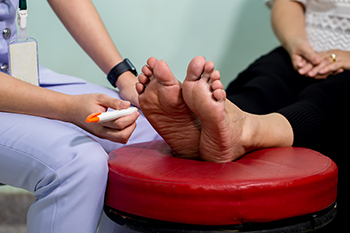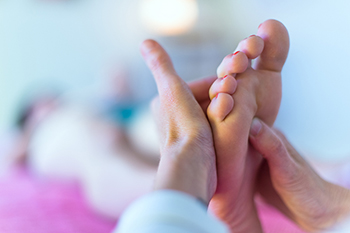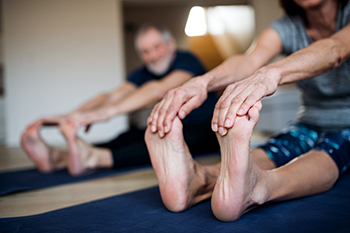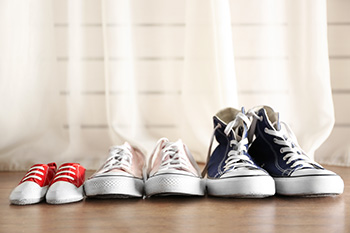Connect With Us
Blog
Items filtered by date: October 2023
Causes and Symptoms of Diabetic Neuropathy

Diabetic neuropathy most often affects the peripheral regions or extremities, including the feet, which tend to bear the greatest brunt of diabetic nerve damage. Prolonged periods of uncontrolled high blood sugar can trigger a number of problematic conditions that can afflict your feet, collectively termed the diabetic foot. This encompasses a range of issues, ranging from neuropathy related numbness and tingling to more severe complications such as ulcers and infections. Proper diabetes management, a healthy lifestyle, and regular check ups with a podiatrist are essential for preventing or managing this condition, particularly when it affects the feet and lower limbs. Early intervention and a proactive approach to diabetic neuropathy can make a significant difference in preserving your overall well being. If you develop a cut or sore on your foot that does not show signs of healing over time or becomes infected, it is essential to consult a podiatrist as soon as possible. Burning sensations, tingling, weakness, or pain in your feet are often early signs of neuropathy, and should be addressed promptly. For help with this condition, it is suggested that you make an appointment with a podiatrist, who is medically trained to treat diabetic neuropathy.
Diabetic foot care is important in preventing foot ailments such as ulcers. If you are suffering from diabetes or have any other concerns about your feet, contact Matthew Fillipi, DPM from Practice. Our doctor can provide the care you need to keep you pain-free and on your feet.
Diabetic Foot Care
Diabetes affects millions of people every year. The condition can damage blood vessels in many parts of the body, especially the feet. Because of this, taking care of your feet is essential if you have diabetes, and having a podiatrist help monitor your foot health is highly recommended.
The Importance of Caring for Your Feet
- Routinely inspect your feet for bruises or sores.
- Wear socks that fit your feet comfortably.
- Wear comfortable shoes that provide adequate support.
Patients with diabetes should have their doctor monitor their blood levels, as blood sugar levels play such a huge role in diabetic care. Monitoring these levels on a regular basis is highly advised.
It is always best to inform your healthcare professional of any concerns you may have regarding your feet, especially for diabetic patients. Early treatment and routine foot examinations are keys to maintaining proper health, especially because severe complications can arise if proper treatment is not applied.
If you have any questions please feel free to contact our office located in East Longmeadow, MA . We offer the newest diagnostic and treatment technologies for all your foot and ankle needs.
Benefits of Foot Massage

Foot massage is a practice that offers numerous benefits and is something that can be incorporated into a good foot care routine. Our feet work tirelessly, supporting us daily, and deserve regular pampering. Foot massages can induce profound calmness and psychological well-being. These massages promote overall foot health by stimulating muscles, enhancing circulation, reducing stiffness, and detecting issues like blisters, bunions, corns, and toenail problems. For heel pain, especially in plantar fasciitis cases, foot massages provide immediate relief, beneficial for flat-footed individuals. Improved circulation, critical for diabetics, is another advantage. Additionally, they expedite injury recovery and reduce the risk of future ones when combined with strengthening exercises. If you have foot pain or would like to learn more about therapies like foot massage and good foot care practices, it is suggested that you make an appointment with a podiatrist who can provide treatment and information you are seeking.
Foot therapy is often necessary for those recovering from either foot deformities or foot injuries. If you have concerns regarding therapy, consult with Matthew Fillipi, DPM from Practice. Our doctor can provide the care you need to keep you pain-free and on your feet.
Most Common Injuries
People who are active or athletes are prone to a variety of injuries. Therefore, it is often important to take part in physical therapy in order to quickly get back on the right track.
What to Do When Injured
Physical Therapy – This specialized treatment will focus on the affected area, speeding up recovery and the overall healing process. It is a proven method that has helped millions of people return from any injury.
During physical therapy you will undergo regimented training to get back into full form. Training is often very difficult, especially at first when the foot feels weak. Physical therapy often involves:
Basic stretching and twisting exercises – getting the feet’s mobility and flexibility up.
Massaging – the therapist will massage the injured area in order to activate the muscles and relax them.
Strengthening Exercises – this allows the muscles in the affected area to regain their full strength, a vital step towards full recovery.
If you have any questions please feel free to contact our office located in East Longmeadow, MA . We offer the newest diagnostic tools and technology to treat your foot and ankle needs.
Foot Stretches to Relieve Arch Pain

Managing arch pain can be a hindrance to your daily activities, but specific types of exercises can help to alleviate this discomfort and strengthen the arches of your feet. One effective exercise is the arch stretch. This can help foot conditions such as plantar fasciitis Simply sit on the floor and place a tennis ball under the arch of your foot. Roll the ball gently, allowing it to massage the arch area. Another helpful foot stretch is toe tapping. While seated, lift your foot off the ground and tap your toes on the floor, starting slowly and gradually increasing the speed. Towel curls are excellent for strengthening the muscles of the arch. These are done by sitting on a chair with your foot on a towel placed on the floor, and scrunching the towel using your toes. Regularly performing these exercises can relieve arch pain and contribute to stronger, more resilient feet. If you would like additional foot stretches to perform for relieving arch pain, it is suggested that you consult a podiatrist.
Stretching the feet is a great way to prevent injuries. If you have any concerns with your feet consult with Matthew Fillipi, DPM from Practice. Our doctor will assess your condition and provide you with quality foot and ankle treatment.
Stretching the Feet
Being the backbone of the body, the feet carry your entire weight and can easily become overexerted, causing cramps and pain. As with any body part, stretching your feet can serve many benefits. From increasing flexibility to even providing some pain relief, be sure to give your feet a stretch from time to time. This is especially important for athletes or anyone performing aerobic exercises, but anyone experiencing foot pain or is on their feet constantly should also engage in this practice.
Great ways to stretch your feet:
- Crossing one leg over the others and carefully pull your toes back. Do 10-20 repetitions and repeat the process for each foot
- Face a wall with your arms out and hands flat against the wall. Step back with one foot and keep it flat on the floor while moving the other leg forward. Lean towards the wall until you feel a stretch. Hold for 30 seconds and perform 10 repetitions for each foot
- Be sure not to overextend or push your limbs too hard or you could risk pulling or straining your muscle
Individuals who tend to their feet by regular stretching every day should be able to minimize foot pain and prevent new problems from arising.
If you have any questions, please feel free to contact our office located in East Longmeadow, MA . We offer the newest diagnostic and treatment technologies for all your foot care needs.
Get Proper Care for a Sports-Related Foot or Ankle Injury This Fall
How Shoes Can Affect Your Foot Health

Proper footwear is essential for preventing various foot conditions and discomfort. Here are some key considerations to keep in mind when choosing your footwear. Those who stand for extended periods on hard surfaces like concrete may experience heel and forefoot pain and calluses and corns. Opt for supportive shoes with softer soles and arch support to alleviate these stresses. This helps distribute your weight more evenly and reduces pressure on the feet. If you have foot soreness, consider lace-up boots. These boots can help maintain leg alignment and distribute even pressure on the muscles and ligaments around your foot. While high heels may be fashionable, they can cause forefoot pressure and deformities. By limiting their use, you can promote better foot health. For those engaged in physical activities, look for shoes that provide cushioning for shock absorption during activities such as running and jumping. Flexibility at the ball of the foot and proper heel support are other essential features. For further help with taking care of your feet through appropriate footwear, it is suggested that you seek the help of a podiatrist.
Everyday foot care is very important to prevent infection and other foot ailments. If you need your feet checked, contact Matthew Fillipi, DPM from Practice. Our doctor can provide the care you need to keep you pain-free and on your feet.
Everyday Foot Care
Often, people take care of their bodies, face and hair more so than they do for their feet. But the feet are a very important aspect of our bodies, and one that we should pay more attention to. Without our feet, we would not be able to perform most daily tasks.
It is best to check your feet regularly to make sure there are no new bruises or cuts that you may not have noticed before. For dry feet, moisturizer can easily be a remedy and can be applied as often as necessary to the affected areas. Wearing shoes that fit well can also help you maintain good foot health, as well as making it easier to walk and do daily activities without the stress or pain of ill-fitting shoes, high heels, or even flip flops. Wearing clean socks with closed shoes is important to ensure that sweat and bacteria do not accumulate within the shoe. Clean socks help to prevent Athlete’s foot, fungi problems, bad odors, and can absorb sweat.
If you have any questions please feel free to contact our office located in East Longmeadow, MA . We offer the newest diagnostic and treatment technologies for all your foot and ankle needs.
Causes of Blisters Between the Toes

Blisters between the toes can be both painful and frustrating. Blisters between the toes often develop due to friction, moisture, or improperly fitting footwear. Friction, the repeated rubbing of toes against each other or the interior of your shoes, is a common culprit. When sweat and moisture become trapped between the toes, it creates an ideal environment for blisters to form. Wearing ill fitting shoes, whether they are too tight or too loose, can exacerbate the problem. Additionally, certain skin conditions such as athlete's foot can render the skin more susceptible to blistering. To address blisters between the toes, it is important to maintain proper foot hygiene and cover the affected area with a bandage. Avoid the temptation to pop blisters, as doing so can lead to infections. Embrace moisture-wicking socks, including toe socks that resemble gloves for the feet. Wearing these may help to reduce moisture between the toes. Ensure your footwear offers an appropriate fit and explore the use of toe protectors or blister pads to reduce friction. If the blisters persist or show signs of infection, it is suggested that you make an appointment with a podiatrist who can safely deal with any problem they have caused.
Blisters are prone to making everyday activities extremely uncomfortable. If your feet are hurting, contact Matthew Fillipi, DPM of Practice. Our doctor can provide the care you need to keep you pain-free and on your feet.
Foot Blisters
Foot blisters develop as a result of constantly wearing tight or ill-fitting footwear. This happens due to the constant rubbing from the shoe, which can often lead to pain.
What Are Foot Blisters?
A foot blister is a small fluid-filled pocket that forms on the upper-most layer of the skin. Blisters are filled with clear fluid and can lead to blood drainage or pus if the area becomes infected.
How Do Blisters Form?
Blisters on the feet are often the result of constant friction of skin and material, usually by shoe rubbing. Walking in sandals, boots, or shoes that don’t fit properly for long periods of time can result in a blister. Having consistent foot moisture and humidity can easily lead to blister formation.
Prevention & Treatment
It is important to properly care for the affected area in order to prevent infection and ease the pain. Do not lance the blister and use a Band-Aid to provide pain relief. Also, be sure to keep your feet dry and wear proper fitting shoes. If you see blood or pus in a blister, seek assistance from a podiatrist.
If you have any questions, please feel free to contact our office located in East Longmeadow, MA . We offer the newest diagnostic and treatment technologies for all your foot care needs.




